|
Chapter Twelve
Tioga County, Pennsylvania
A short chronological history should be
appropriate in order to understand the Area that Thomas and Ann were going to
live:
1806-
Wellsboro, Pa. , was chosen as the County Seat.
1823-
A tannery was erected in Mansfield by Chandler Mann.
1824-
The first newspaper was published, called "Pioneer"
1826-
A law was passed for the development of a canal to carry coal from Blossburg.
1829-
Stephen Potter, master builder, built Seymour House in Blossburg.
1832-
Richard C. Taylor made a survey for a railroad through Tioga County and made a
geological survey map of the Blossburg coal regions.
1839-
The Arbor Coal Company was formed.
1840-
The Blossburg to Corning railroad began service.
1841-
Sir Charles Lyell, an English scientist, visits the Blossburg coal region for
the purpose of examining its resources and comparing it with English Coal.
1843-
The Arbor Coal Company fails and is succeeded by William Mallory.
1847-
A glass factory was established in Blossburg by Horace B. Clarke.
1848-
The Tioga & Elmira Plank Road Co. was incorporated.
1850-
The Tioga Plank road becomes on of the most important interests in the County.
1851-
The Hon. James Magee becomes interested in the Blossburg coal business.
1852-
A railroad is built between Blossburg and Morris Run.
1853-
The Tioga Improvement Co. mined coal at Morris Run.
1855-
St. Andrews Roman Catholic Church was erected in Blossburg.
1859-
The Fallbrook Coal Company was incorporated by John Magee and James Gulick.
1860-
2,200 soldiers, out of a population of 6,000, sign up for the Civil War
recruitment.
1862-
The Mansfield Classical Seminary becomes a State Normal School.
1864-
The Tioga Improvement Co. is succeeded by the Morris Run Mining Company.
1865-
January 1st marked the beginning of a mine strike at Fallbrook that
ended in May.
1865-
Thomas Kilmartin and family move to Morris Run.
1870-
The U.S. Census shows the names of Gilmartin, Hayes, Driscoll, and Clarke.
1871-
William B. Wilson, former Senator, Labor Secretary. and native of Morris Run,
died.
1871-
The Blossburg Township formed from Bloss Township fire Dept. in Blossburg.
1872-
Hamilton Township (Morris Run) formed from Bloss Township.
1873-
H. S. Drake, of Corning, was connected with the mining interests in Arnot.
1873-
A major strike hits all the coal mines.
1864-1874
Ten years coal production in tons: In Morris Run, 3,176,181; in Fallbrook,
2,755,953; in Blossburg and Arnot, 1,427,024.
1876-
The County celebrates the United States Centennial and Thomas becomes a U.S.
citizen.
1877-
The burning of the Bloss Coal and Lumber Co. occurs.
1877-
Father Murphy conducts Temperance Union Revival.
|
As coal was an important part of
the lives of Thomas and his family, I will now take some time to cover the Tioga
Lockout of 1873. This description of the lockout is a typical story of a miners
life in Pennsylvania and the United States during those years.
In 1873, in the vicinity of Blossburg, Tioga
County, there were deposits of bituminous coal. This coal was in demand by the
railways and steam facilities for its great heating power. The process was
referred to as smithing coal.
|
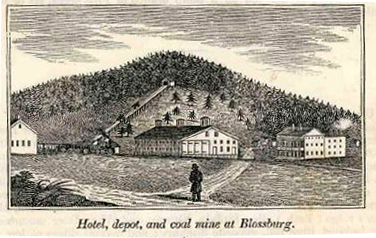
This print was removed from
the 1843 edition of Sherman Day's book "Historical Collections of the State
of Pennsylvania containing A Copious Selection of the most Interesting
Facts, Traditions, Biographical Sketches, Anecdotes Etc. relating to its
History and Antiquities, Both general and Local with Geographical
Descriptions of Every County and all the Larger towns in the State."
|
|
Three coal companies, Blossburg,
Morris Run, and Fallbrook, owned the land, operated the mines, and controlled
the lives of the inhabitants. The so-called Tioga System was designated to make
strikes impossible. |
Roads entering the town were regarded as private. Persons deemed
objectionable to the mining company could be arrested as trespassers. The houses
occupied by the workers and their families were only rented to them. The
companies managed to have the state legislature in Pennsylvania and New York
pass bills that permitted the company to evict the tenants with only ten days
notice. The workers were paid once a month with company currency, which was good
only in the company stores. Credit in the stores was advanced to the workers
between paydays. This system of fines for misdemeanors was easily taken
advantage of by the company superintendents. It kept many workers in debt to the
company and kept them dependent on it.
There were no labor difficulties between 1845 and
1873, but the company built up a vast reservoir of resentment.
In the winter of 1873 the demand for
semi-bituminous coal fell off. The company withheld cash wages, allowing the
workers company credit in their stores for three months. In November of 1873, as
Herbert Gutman tells the story in the "Pennsylvania Magazine of History
and Biography," July 1959 edition, "The companies offered the men
no more wages until the following May. The miners refused and formed a local
union, "The Miners and Laborers Benevolent Union of Tioga County," to
speak for them. The companies immediately fired the Union leaders. In 1873, all
who refused to sever their connection with the Union were threatened with
eviction. The men protested bitterly, saying that the employers were forcing
them to "put on the badge of serfdom." A Fallbrook official declared,
" we are justified in our proceedings, to our consciences and before God
and man." The owners believed that the cold weather and business depression
would force the men to terms, destroy the union and save the Tioga System.
The owners were wrong. The people of the region
began to prove that they could exert pressure. The merchants and the farmers
showed their sympathy for the miners by lodging them in their homes and hire
lawyers to test the eviction in court. John Sidney, a Union leader, after
observing the support citizens had given the Union, called it a "City of
Refuge." The lockout failed. In March, 1874, the operators recognized the
Union (for a while) and the men went back to work. The Miners and Benevolent
Association met its death in the long strike. The struggle over wages lasted
from February to July, 1875. The public was now suspicious of the mining
community because of the violence of the Molly Maguires. Their killings and
agitation was in the anthracite area of Hazelton and Scranton. The public was
now unsympathetic. As the strike dragged on the Union funds became exhausted and
the organization collapsed. The miners, ever a tuneful lot, expressed their
feelings in a song written by one of their minstrels:
"Well, we’ve been
beaten, beaten all to smash,
and now sir, we begin to feel
the lash,
as wielded by a gigantic
corporation
which runs the commonwealth and
ruins the nation,
Our union lamp, friend John
Siney, no longer shineth,
It’s gone up where the gentle
woodbine twineth."
The excesses of the Molly Maguires had injured
the miners cause at the time. The Kilmartin’s, Driscoll’s, Hayes, Neary’s,
Clarke’s, and loyal friends in the three coal mine area continued the long
dreary years fighting poverty, stupidity, and the tight reins of inescapable
hopelessness.
The eight hour working day was passed in Congress
in 1868, but its effects never reached the mines or steel workers. In 1869
miners pay was $14.00 a week. Outside labor was $11.00 a week, and a platform
mans weekly salary was $11.50 for inside labor. Labor conditions, ranging from
strikes to little work to full employment, lasted right on through 1900. Union
President John A. Mitchell called a strike in 1900 which lasted six months. Only
President Teddy Roosevelt’s threat to send in the Army persuaded the owners to
submit the dispute to arbitration. By October 23, 1902, the strike was settled
and the miners went back to work. The award extended the eight hour day, raise
the miners wages, and recognized the authority of the Union. Many of the abuses
of the miners life still occurred. Safety hazards, explosions, and death, were
still big problems.
The family album has several pictures of the clan
gathered together on the "Porch" of their family home, dressed in
their Sunday best, celebrating some special occasion. They looked like proud
aristocrats, which in our eyes they are. Other pictures show them posing in
baseball uniforms, sledding, or on a hay ride, able to find fun and activity in
their homes.
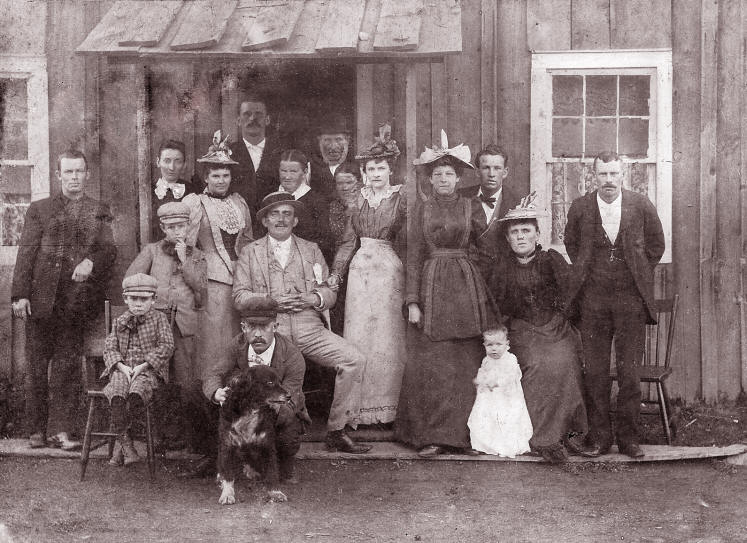
THE GILMARTIN’S IN 1893- FROM
FAR LEFT BACK ROW IS MICHAEL GILMARTIN (AUTHOR’S GRANDFATHER), ELIZABETH
(O’NEIL) GILMARTIN (MICHEAL’S WIFE) CATHERINE (GILMARTIN) O’HARA (DAUGHTER
OF TOM AND ANN), WILLIAM O’HARA, THOMAS KILMARTIN, ANN KILMARTIN, EILSHA
CLARKE (DAUGHTER OF JOE & MARY CLARKE), NORA (HAYES) GILMARTIN (TAYLOR’S
WIFE), WILLIAM (TAYLOR) GILMARTIN, HANNA (GANEY) GILMARTIN (WIFE OF JAMES
KILMARTIN), MR. GANEY (BROTHER OF HANNA) . YOUNG BOY STANDING TO THE LEFT OF
CENTER IS JOSEPH GILMARTIN, (SON OF MICHAEL), SEATED IS JOSEPH CLARKE, DIRECTLY
BEHIND JOSEPH IS HIS WIFE MARY ( KILMARTIN) CLARKE, IN FRONT OF JOSEPH IS FRANK
CLARKE (STEP-SON OF JOE CLARKE), SEATED BOY IS JAMES GILMARTIN (AUTHOR’S
FATHER), & THE BABY TO RIGHT IN FRONT IS NELLIE GILMARTIN, DAUGHTER OF
HANNAH (GANEY) GILMARTIN.
Dad (James Patrick Gilmartin) tells the story of
riding down the snow covered hills from the town of Arnot and crashing into a
cow, causing Dad to break his leg. Mother (Katherine Guiry Gilmartin) told of
her hay ride to Canton with her first boyfriend, Jack Feeney. I have collected
several books with pictures of Blossburg, surrounding towns, and centennial
memorials. Katherine (Gilmartin Kaufmann), Joe (Gilmartin), and I remembered
the trips we took to Morris Run as very young children, going to the abandoned
mine, crossing the steep slate hills, and picking berries. One berry expedition
brought me a face to face encounter with a rattlesnake. Our Tomboy neighbor
crushed the demon with a large rock. I still see the fangs from the eyes of an
eight year old boy.
Many epitaphs are written on the grave stones,
one I have written down:
Farewell dear wife, my life is
past,
My love was true while life did
last,
And now for me, no sorrow make,
But love my children for my
sake.
Industrious husband have I
been,
Many troubles have I seen,
But they have brought me leave
to rest,
In hopes to rise among the
blest.
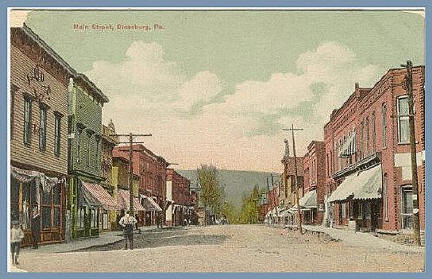
Main St. Blossburg, Pa in 1899
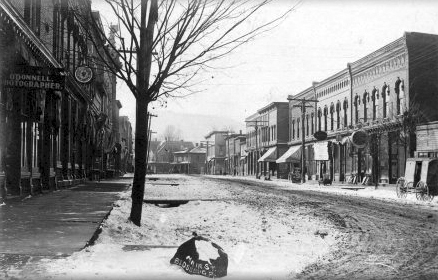
Blossburg PA, early 20th Century.
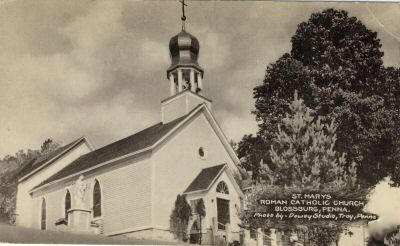
St. Mary's Roman Catholic Church, Blossburg, Pa
Mary and I took our three children, Joan, Regina,
and Edward, to the last home Frank Guiry lived in. The home was formerly lived
in by all the Guiry’s from 1899-1948. Frank closed the house and sold it in
1948. We toured the house and I could vaguely remember where I slept in a
feather bed. I did remember, however, the outhouse and the well down the road,
now closed. The heaping slag pile had disappeared for road repairs, and the mine
was closed.
Chapter 13
Top of Page
|
